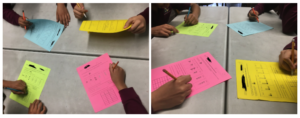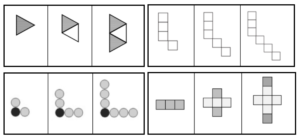Do you ever feel that your students aren’t engaged enough in the content you are currently teaching? As if the material is going right over their heads? That you’re trying your best to make your material is relevant, interactive and fun, but it still doesn’t seem to click?
I, like many other math educators, have found this to be a constant struggle throughout my years as an educator.
Expecting Engagement, Witnessing Confusion
Oftentimes, I find myself designing lessons that I hope will engage my students, but end up scrapping it entirely after teaching it for the first time. I recall disappointedly apologizing to my students on more than one occasion for teaching a lesson that led to many confused faces.
Maybe I didn’t have enough supports for the students, or maybe I didn’t give enough opportunities to really delve deep into the material? Regardless, I felt I wasn’t doing my job to reach ALL learners in my classroom, and I decided that needed to change.
Students As Social Beings
ALL learners have much knowledge to gain from one another, despite not knowing the specific content. We are all social, curious, inquisitive beings, and learners must be given the opportunity to use these innate abilities in the classroom. Research suggests that cooperative learning in middle school classrooms produces greater math achievement (PDF).
Cooperative learning activities allows for an increase in positive peer interactions, which is especially helpful for our English Language Learners (ELLs). When working alongside students who are not ELLs, an ELL’s language acquisition is further developed because they are tasked with learning and using academic vocabulary in these collaborative spaces.
To best support ALL learners in my classroom, I have made it a goal of mine this year to prioritize the use of personalized learning through cooperative learning in order to reach ALL learners. Specifically, the cooperative learning strategies I have incorporated into my classroom are investigation and the “jigsaw” technique.
- Investigation allows students the opportunity to engage in the material without being given much to work with.
- The “jigsaw” technique gives students the opportunity to become “experts” on a specific topic and then teach their peers about that topic.
Investigating Linear Patterns
For the last few units, I have begun each unit with an investigation activity that would introduce them to the topic of the given unit. For my linear equations unit, I created an activity where students were asked to investigate patterns in a given design.
Students were grouped homogeneously based on diagnostic test scores, and each group was given a specific pattern. Students were given the task to observe the pattern, determine the next 3 parts of the pattern, and then create a table, graph and equation that would describe the linear pattern.
At this point, students hadn’t been taught much about linear equations or linear relationships. As you can imagine, many questions were asked, but since it was an investigation, intentionally not many were answered. Students were given the opportunity to collaboratively explore and develop their aptitude for skillful inquiry.
After investigating the pattern that was given to their specific group (based on ability), students “jigsawed” to a new group with members who all had different patterns. Each member of the new group had a different pattern and were asked to describe their pattern to the new group members, explain their findings, and determine any similarities between the different patterns.
Reflecting…
During the activity ALL learners were…
- Engaged in conversation
- Asking and answering questions
- Using critical thinking and problem solving skills
- Justifying their thinking
When I taught this unit last year, students were often disengaged. They were constantly confused by the material, and continued to be until the summative assessment at the end of the unit. That was not the case this year.
Now, students have a better understanding of linear relationships. By learning from each other, students were able to ask questions and use newly developed critical thinking and problem solving skills that allowed them to retain more information than even I had expected. This is especially the case for my English Language Learners, who now feel more comfortable using mathematical vocabulary in a larger group setting.
Who would have thought that by including collaboration students would be able to be more engaged? That they would be able to retain more information? I sure didn’t. Knowing what I know now, I look forward to incorporating many more cooperative activities in my classroom next year, and the years to follow.
For more information on implementing collaborative/cooperative activities in the math classroom please visit:
- Building Collaborative Problem Solvers – Edutopia
- Exploring and Investigating in Mathematics Teaching and Learning (PDF) by João Pedro da Ponte
- Collaborative Learning in Mathematics (PDF) by Malcolm Swan
Bryant A. Estrada is a High School Mathematics teacher at Blackstone Academy Charter School in Pawtucket, RI. Bryant believes that using literacy strategies and collaborative learning techniques in the mathematics classroom allows for increased equity for ALL learners. When he is not in the classroom, you can either find Bryant engaging in dialogue regarding access and equity in urban education, working on his Masters of Education in Urban Teaching, or practicing in the dance studio for his next salsa performance.
Bryant A. Estrada is a High School Mathematics teacher at Blackstone Academy Charter School in Pawtucket, RI. Bryant A. Estrada is a High School Mathematics teacher at Blackstone Academy Charter School in Pawtucket, RI. SaveSave

